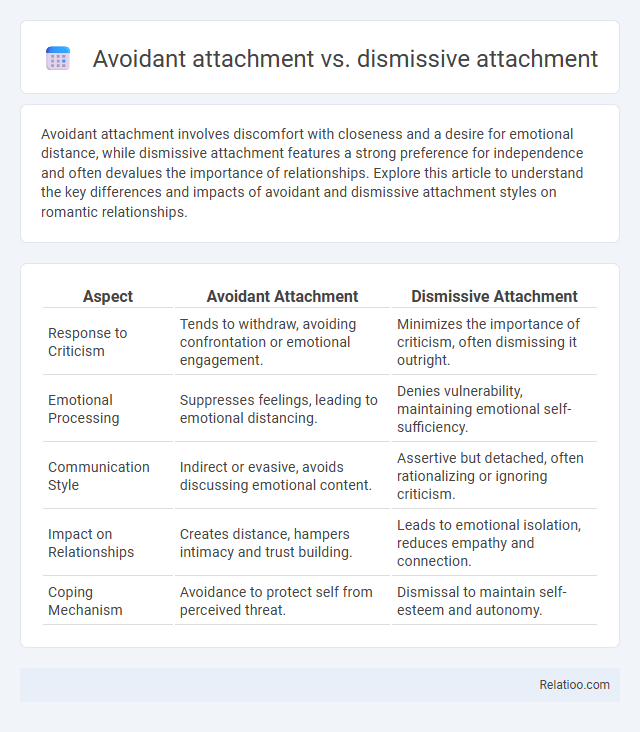Avoidant attachment involves discomfort with closeness and a desire for emotional distance, while dismissive attachment features a strong preference for independence and often devalues the importance of relationships. Explore this article to understand the key differences and impacts of avoidant and dismissive attachment styles on romantic relationships.
Table of Comparison
| Aspect | Avoidant Attachment | Dismissive Attachment |
|---|---|---|
| Response to Criticism | Tends to withdraw, avoiding confrontation or emotional engagement. | Minimizes the importance of criticism, often dismissing it outright. |
| Emotional Processing | Suppresses feelings, leading to emotional distancing. | Denies vulnerability, maintaining emotional self-sufficiency. |
| Communication Style | Indirect or evasive, avoids discussing emotional content. | Assertive but detached, often rationalizing or ignoring criticism. |
| Impact on Relationships | Creates distance, hampers intimacy and trust building. | Leads to emotional isolation, reduces empathy and connection. |
| Coping Mechanism | Avoidance to protect self from perceived threat. | Dismissal to maintain self-esteem and autonomy. |
Understanding Attachment Styles
Understanding attachment styles involves recognizing how Avoidant, Dismissive, and Anxious Avoidant attachments influence your relationships and emotional responses. Avoidant attachment is characterized by discomfort with closeness and emotional distance, while Dismissive attachment reflects a tendency to downplay the importance of relationships and suppress feelings. Differentiating these styles helps you identify patterns in your behavior and fosters healthier interpersonal connections.
Defining Avoidant Attachment
Avoidant attachment is characterized by a consistent discomfort with closeness and a preference for emotional distance in relationships, often stemming from early caregiving experiences marked by unresponsiveness. Dismissive attachment, a subtype of avoidant attachment, specifically involves a defensive tendency to downplay the importance of relationships and suppress emotional needs, leading to self-reliance and emotional detachment. Understanding avoidant attachment requires recognizing its core features of avoidance of intimacy and suppression of affect, which differentiate it from other attachment styles like anxious or secure attachment.
What Is Dismissive Attachment?
Dismissive attachment is a subtype of avoidant attachment characterized by a strong need for independence and emotional distance from others, often leading individuals to suppress their feelings and avoid closeness. Unlike general avoidant attachment, which may involve fear of intimacy and discomfort with closeness, dismissive attachment involves a defensive strategy of valuing self-reliance over relationships. Understanding your own patterns of dismissive attachment can help improve emotional connections and foster healthier interpersonal dynamics.
Key Differences Between Avoidant and Dismissive Attachment
Avoidant attachment and dismissive attachment share a core tendency to distance oneself emotionally in relationships, but dismissive attachment is characterized by a stronger emphasis on independence and denial of attachment needs, often accompanied by a positive self-view and a negative view of others. Avoidant attachment generally involves discomfort with closeness and a tendency to suppress emotions, while dismissive attachment specifically devalues intimacy and attachments as a defense mechanism to maintain self-reliance. Key differences lie in the underlying motivations: avoidant attachment stems from fear of rejection, whereas dismissive attachment arises from a conscious avoidance of vulnerability and emotional dependence.
Origins and Development of Attachment Styles
Avoidant attachment, stemming from inconsistent caregiving during early childhood, leads to discomfort with closeness and emotional expression, while dismissive attachment arises from caregivers who minimize emotional needs, fostering a sense of self-reliance and detachment. Both attachment styles develop as adaptive responses to unmet emotional needs, shaping how You regulate intimacy and trust in relationships. Understanding these origins helps clarify the developmental pathways influencing Your attachment behaviors and emotional coping mechanisms.
Behavioral Patterns in Relationships
Avoidant attachment is characterized by a strong desire for independence and discomfort with emotional closeness, often leading to emotional withdrawal in relationships. Dismissive attachment involves downplaying the importance of relationships and suppressing feelings, resulting in a tendency to avoid intimacy and prioritize self-reliance. You might notice that both avoidant and dismissive attachment styles show avoidance of deep emotional connection, but dismissive attachment often includes a more overt denial of the need for close relationships.
Emotional Impact of Avoidant vs Dismissive Attachment
Avoidant attachment often leads to suppressed emotions and difficulty forming close relationships, while dismissive attachment involves a more pronounced emotional distancing and denial of attachment needs. Your emotional wellbeing can be affected differently; avoidant individuals may experience internal conflict and anxiety, whereas dismissive attachment fosters detachment and self-reliance at the cost of emotional intimacy. Understanding these distinctions helps address specific emotional challenges in personal development and relationships.
Signs and Symptoms to Recognize
Avoidant attachment manifests through emotional distance, reluctance to depend on others, and discomfort with intimacy, while dismissive attachment is characterized by a strong sense of independence, suppression of emotions, and often denying the need for close relationships. Both attachment styles exhibit avoidance behaviors, but dismissive attachment tends to involve more defensive strategies, such as minimizing the importance of relationships to maintain self-reliance. Recognizing these signs in Your interactions, like consistent withdrawal during emotional conversations or difficulty trusting others, can help identify avoidant or dismissive attachment patterns for better emotional awareness and growth.
Coping Strategies and Healing
Avoidant attachment, dismissive attachment, and fearful-avoidant attachment each involve distinct coping strategies rooted in emotional distancing and self-reliance, with dismissive attachment characterized by suppression of feelings and avoidance of intimacy, while fearful-avoidant attachment combines desire for closeness with fear of rejection. Healing from these attachment styles requires fostering emotional awareness, practicing vulnerability in relationships, and developing secure attachment behaviors through consistent, supportive interpersonal experiences. Therapeutic interventions like cognitive-behavioral therapy (CBT) and emotion-focused therapy (EFT) effectively address underlying fears and promote healthier attachment patterns.
Seeking Professional Help and Support
Avoidant attachment often leads individuals to suppress emotional needs, making professional therapy crucial for learning healthy intimacy skills and emotional expression. Dismissive attachment, characterized by emotional distancing and self-reliance, benefits from counseling that fosters vulnerability and challenges self-sufficiency beliefs. Both styles require tailored support focusing on building trust, enhancing emotional regulation, and developing secure relational patterns through evidence-based interventions like cognitive-behavioral therapy and attachment-focused therapy.

Infographic: Avoidant attachment vs Dismissive attachment
 relatioo.com
relatioo.com